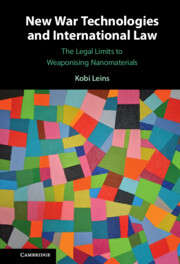Book contents
- New War Technologies and International Law
- New War Technologies and International Law
- Copyright page
- Dedication
- Contents
- Figures
- Acknowledgements
- Abbreviations
- Prolegomenon
- 1 International Law and the Use of Nanomaterials in War
- 2 The Three Technologies Using Nanomaterials
- 3 International Treaty Law
- 4 International Customary Law and Principles
- 5 International Environmental Law and Principles
- 6 International Human Rights Law
- 7 Conclusion and Recommendations
- Bibliography
- Index
5 - International Environmental Law and Principles
Published online by Cambridge University Press: 20 January 2022
- New War Technologies and International Law
- New War Technologies and International Law
- Copyright page
- Dedication
- Contents
- Figures
- Acknowledgements
- Abbreviations
- Prolegomenon
- 1 International Law and the Use of Nanomaterials in War
- 2 The Three Technologies Using Nanomaterials
- 3 International Treaty Law
- 4 International Customary Law and Principles
- 5 International Environmental Law and Principles
- 6 International Human Rights Law
- 7 Conclusion and Recommendations
- Bibliography
- Index
Summary
International environmental law is important to consider during war, as the environment may be seriously harmed during armed conflict, with long-term impact on the environment and human health long after battles pass. In the case of nanomaterials, this harm may even be intergenerational. Nanomaterials enter water tables and food chains; are able to move across human membranes; and may reside in the human body indefinitely. Scientists are only just beginning to understand the potentially toxic effects of nanomaterials on the environment and the human body in the short and long term. Protection of the environment during armed conflict requires not only high-level international legal agreements but also practical rules and granular guidance in military manuals and instructions that can be correctly applied in any battlefield. For this reason, the perspective of this chapter broadens beyond traditional international laws of war to examine how international environmental law should be used to review and address the effects of nanomaterials from ‘means or methods of warfare’ to the environment. The risks of potential long-term harm of environmental damage during war are increasingly being discussed in international fora.1
- Type
- Chapter
- Information
- New War Technologies and International LawThe Legal Limits to Weaponising Nanomaterials, pp. 119 - 164Publisher: Cambridge University PressPrint publication year: 2022



